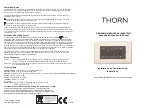
1-3
Configuration Procedure
Follow these steps to configure a static route:
To do…
Use the command…
Remarks
Enter system view
system-view
—
ip route-static dest-address
{
mask
|
mask-length
}
{
next-hop-address | interface-type interface-number
next-hop-address
|
vpn-instance
d-vpn-instance-name next-hop-address
}
[
preference
preference-value
] [
tag tag-value
]
[
description description-text
]
Configure a static
route
ip route-static vpn-instance
s-vpn-instance-name&<1-6> dest-address
{
mask |
mask-length
} {
next-hop-address
[
public
] |
interface-type interface-number next-hop-address
|
vpn-instance d-vpn-instance-name
next-hop-address
} [
preference preference-value
]
[
tag tag-value
] [
description description-text
]
Required
By default,
preference
for
static routes is 60,
tag
is 0, and no
description
information is
configured.
Configure the default
preference for static
routes
ip route-static default-preference
default-preference-value
Optional
60 by default
z
When configuring a static route, the static route does not take effect if you specify the next hop
address first and then configure it as the IP address of a local interface.
z
If you do not specify the preference when configuring a static route, the default preference will be
used. Reconfiguring the default preference applies only to newly created static routes.
z
You can flexibly control static routes by configuring tag values and using the tag values in the
routing policy.
z
If the destination IP address and mask are both configured as 0.0.0.0 with the
ip route-static
command, the route is the default route.
Detecting Reachability of the Static Route’s Nexthop
If a static route fails due to a topology change or a fault, the connection will be interrupted. To improve
network stability, the system needs to detect reachability of the static route’s next hop and switch to a
backup route once the next hop is unreachable.
There are two methods of detecting reachability of the static route’s next hop. Note that only one of the
two methods can be used at a time.
Detecting Nexthop Reachability Through BFD
Bidirectional forwarding detection (BFD) provides a general-purpose, standard, medium- and
protocol-independent fast failure detection mechanism. It can uniformly and quickly detect the failures
of the bidirectional forwarding paths between two routers for upper-layer protocols, such as routing
















































